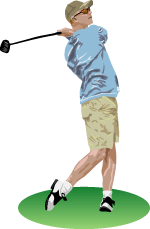There are literally hundreds of pedometers on the market, and while many will do all sorts of things, some of which have nothing to do with walking or running, they all are designed to do at least one thing: measure how many steps you have taken and use that to compute how far you have traveled.
If all you are interested in is how many steps you have taken, then clip that pedometer to your belt and start walking (though check it is doing that accurately). But if you want to know how far you have walked or run in a day, or a week, then you must give the pedometer some information about yourself. Specifically, the pedometer must know the length of your stride. This article will tell you how to gage that length to properly calibrate your pedometer.
First, a caveat: your stride length will vary considerably during your routine depending on certain factors. For example, your stride length will be longer when you are running than it is when you are walking. Your stride is likely to be shorter when going uphill as opposed to walking on a level surface. Walking with a group of people may cause you to move at different speeds and at different stride lengths as you compensate for the movement of your partners. Walking a dog will give you strides that go from very short to very long depending on the whims of your dog, but that is for a different time. So, one of the steps will be to compensate for these differences, if necessary.
Okay, let’s begin the calibration process. You will need some place where you can measure out a distance of about 60 to 70 feet (18.3 to 21.3 meters). The sidewalk in front of your home is good, or a large parking lot or school yard. And you will need a measuring device such as a 100’ tape measure. You should plan on measuring at least four stride lengths: normal walk, brisk or fast walk, jog, and run. The procedure will be that same for all of these.
Select a starting point and mark it; then walk normally for ten paces and mark the end. Measure the length with the tape measure and record the result. Divide the result by twelve to give you the number of inches in each step. Repeat this procedure for a brisk walk, a jog and a run. For all of these you might want to begin a few paces behind the starting point that you established earlier so that you are moving at the proper speed for that stride for all ten steps.
 measuring your stride
measuring your strideIf you know that you will be walking, and just walking, at a regular pace during your routine, then you can just use the stride length for walking that you calculated. Read the instructions for entering that information into your pedometer.
If, however, you will be walking part of the time combined with running or jogging then you will have to use an average of the measurements that you took of all of these strides. Simply add the totals that you calculated and divide by four, or the number of strides that you measured. This gives you a number that is less than your running stride, but longer than your walking stride.
Some pedometers will give you the option of entering a stride length for both walking and running, but this means that you will have to tell the pedometer when you are walking and when you are running. That seems like a lot of trouble to go to if you do both of those things during your regular routine. So, we will make an adjustment for that.
There is one more step to complete in this process. Drive your car along your regular path to determine the correct distance of that path. Then walk the same path using your pedometer. If the pedometer gives you a distance significantly longer or shorter than that which your car’s odometer registered then you will have to adjust the stride length that you entered into your pedometer. If you are registering a distance that is longer than that measured with your car, then you must reenter a stride length a few inches shorter. Similarly, if the distance measured by your pedometer is shorter than your car’s odometer, then add a few inches to the stride length.
Once you have done this over the course of a few days, then you will have a result which will give you a pretty good measurement of the distance traveled during your routine. You can use this information as a great motivator as you walk or run further in your daily routine. Now that you have properly set up your pedometer, clip it to your belt and start walking!
guest post article by George Barnett
Related Pages
- See Pedometer home
- Is My Pedometer Accurate? — calibrating your step count.
- Fitbit — a review of the pedometer with extras
- Energy Expenditure using a Pedometer — by counting steps you can estimate how much energy you are using.
- If you haven't got one yet, visit the Pedometer Store for a selection of pedometers to purchase.
- Calibrating fitness testing equipment



